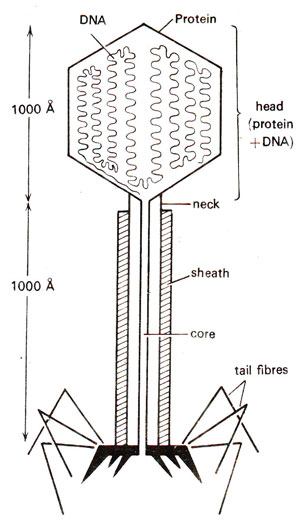Experiments with bacteriophage (T2) infection

Fig. 25.3. Structure of T2 bacteriophage.

Fig. 25.4. Experiment of Hershey and Chase, where DNA of bacteriophage is labelled with P32, and the protein is labeled with S35.
In 1952, A.D. Hershey and M.J. Chase reported results of experiments which demonstrated that only DNA of the phage enters host cells and that this DNA carries all the genetic information necessary for assembly of new phage progeny. In these experiments, phage DNA was made radioactive by growing infected bacteria on a medium containing 35PO4. Since phage proteins do not contain phosphorus, only DNA would be labelled. Similarly, phage proteins were labelled with the help of 35SO4. Since DNA does not contain sulphur, only protein would be labelled with S35. Such differential labelling would enable one to distinguish between DNA and proteins of the phage without performing any chemical tests. Hershey and Chase then allowed both kinds of labelled phage particles to infect bacteria. The infected bacteria were immediately agitated in a waring blender. After shaking, only radioactive 32P was found associated with bacterial cells and 35S was found only in surrounding medium and not in bacterial cells. When phage progeny was studied for radioactivity in this experiment, it was found that the phage progeny carried label only with 32P. The progeny was not labelled with 35S. This experiment is diagrammatically represented in Figure 25.4 and clearly indicated that only DNA and not protein enters the bacterial cells. The protein coat is left outside. This DNA entering the host cell carries all the genetic information, for synthesis of new phage particles. Indirectly, this experiment conducted by Hershey and Chase proved that DNA is the sole genetic material in DNA bacteriophages. As earlier mentioned in Sexuality and Recombination in Bacteria and Viruses dealing with bacteria and viruses, A.D. Hershey shared with M. Delbruckand S.E. Luria, the Nobel Prize in medicine for 1969.




